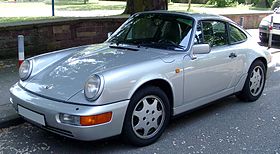Porsche 969
| Porsche 964 | |
|---|---|
 |
|
| Overview | |
| Manufacturer | Porsche |
| Also called | Porsche 911 Porsche Carrera |
| Production | 1989–1994 62,172 built |
| Assembly | Stuttgart, Baden-Württemberg, Germany |
| Designer | Benjamin Dimson (1985, 1986) |
| Body and chassis | |
| Class | Sports car (S) |
| Body style | 2-door coupe 2-door convertible 2-door targa |
| Layout |
RR layout R4 layout |
| Powertrain | |
| Engine | 3.3 L M30/69 turbo flat-6 3.6 L M64/01, 02, 03 3.6 L M64/50 turbo 3.75 L M64/04 (3.8 RS/RSR) |
| Transmission | 4-speed automatic 5-speed manual |
| Dimensions | |
| Wheelbase | 2,270 mm (89.4 in) |
| Length | 4,275 mm (168.3 in) |
| Width | 1,650–1,775 mm (65.0–69.9 in) |
| Height | 1,310–1,320 mm (51.6–52.0 in) |
| Chronology | |
| Predecessor | Porsche 911 classic |
| Successor | Porsche 993 |
The Porsche 964 is the company's internal name for the Porsche 911 manufactured and sold between 1989 and 1994. Designed by Benjamin Dimson through January 1986, it featured significant styling revisions over previous 911 models, most prominently the more integrated bumpers. It was the first car to be offered with Porsche's optional Tiptronic automatic transmission and all wheel drive as options.
Type 964 ("nine-sixty-four", or "nine-six-four") is Porsche's internal code name for the 911 Carrera 2 and 911 Carrera 4 models, which were badged simply as "Carrera 2" and "Carrera 4". "964" is used by automotive publications and enthusiasts to distinguish them from other generations of the Carrera.
The 964 was considered to be 85% new as compared to its predecessor, the Carrera 3.2. The first 964s available in 1989 were all wheel drive equipped "Carrera 4" models; Porsche added the rear wheel drive Carrera 2 variant to the range in 1990. Both variants were available as a coupe, Targa or Cabriolet. The 964 Carrera was the last generation sold with the traditional removable Targa roof until the 2011 991 (993, 996, and 997 versions used instead a complex glass-roof "greenhouse" system). A new naturally aspirated engine called the M64 was used for 964 models, with a flat-6 displacement of 3.6 litres. Porsche substantially revised the suspension, replacing torsion bars with coil springs and shock absorbers. Power steering and ABS brakes were added to the 911 for the first time; both were standard. The exterior bumpers and fog lamps became flush with the car for better aerodynamics. A new electric rear spoiler raised at speeds above 50 mph (80 km/h) and lowered down flush with the rear engine lid at lower speeds. A revised interior featured standard dual airbags beginning in 1990 for all North American production cars. A new automatic climate control system provided improved heating and cooling. Revised instrumentation housed a large set of warning lights that were tied into the car's central warning system, alerting the driver to a possible problem or malfunction.
...
Wikipedia
